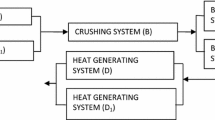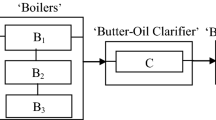Abstract
This paper discusses a feeding system of the sugar industry consisting of six subsystems—unloaders, cane carrier and cutter unit, crushing unit, boiler unit, bagasse carrier unit and turbines. Cane carrier and cutter unit, crushing unit, bagasse carrier unit and boiler unit are working in series. In sub-system ‘unloaders’ one unloader is operative and another is kept as cold standby whereas, in sub-system ‘turbines’ both the turbines work in parallel. The distribution of failure times of sub-systems of feeding system is taken as exponential while the distribution of repair times of sub-systems is considered as arbitrary. The feeding system is analyzed by using supplementary variable technique. A particular case is also considered to show the behavior of availability and profit of the feeding system.


Similar content being viewed by others
References
Agarwal SC, Deepika, Sharma N (2011) Reliability analysis of sugar manufacturing plant using Boolean function technique. Int J Res Rev Appl Sci 6(2):165–171
Aggarwal K, Singh V, Kumar S (2014) Availability analysis and performance optimization of a butter oil production system: a case study. Int J Syst Assur Eng Manag. doi:10.1007/s13198-014-0310-x
Arora N, Kumar D (1997) Availability analysis of steam and power generation systems in the thermal power plant. Microelectron Reliab 37(5):795–799
Cox DR (1955) Analysis of non Markovian stochastic processes by the inclusion of supplementary variables. Proc Comb Philos Soc 51:433–441
Famurewa SM, Asplund M, Galar D, Kumar U (2013) Implementation of performance based maintenance contracting in railway industries. Int J Syst Assur Eng Manag 4(3):231–240
Garg S, Singh J, Singh DV (2010) Availability and maintenance scheduling of a repairable block- board manufacturing system. Int J Reliab Saf 1(1):101–118
Gaver DP (1963) Time to failure and availability of parallel system with repair. IEEE Trans Reliab R-12:30–38
Gupta S, Tewari PC (2009) Simulation modeling and analysis of complex system of thermal power plant. J Ind Eng Manag 2(2):387–406
Gurjar JS (2007) Reliability technology. I.K. International, New Delhi
Jaise J, Kumar ANB, Shanmugam NS et al (2013) Power system: a reliability assessment using FTA. Int J Syst Assur Eng Manag 4(1):78–85
Kadyan MS, Promila, Kumar J (2014) Reliability modeling of a single-unit system with arbitrary distributions subject to different weather conditions. Int J Syst Assur Eng Manag 5(3):313–319
Kumar D, Singh IP, Singh J (1988) Availability of the feeding system in the sugar industry. Microelectron Reliab 28(6):867–871
Kumar D, Pandey PC, Singh J (1990) Design and cost analysis of a refining system in a Sugar industry. Microelectron Reliab 30(6):1025–1028
Kumar S, Mehta NP, Kumar D (1997) Steady state behavior and maintenance planning of a desulphurization system in urea fertilizer plant. Microelectron Reliab 37(6):949–953
Kumar J, Kadyan MS, Malik SC (2011) Profit analysis of a 2-out-of-2 redundant system with single standby and degradation of the units after repair. Int J Syst Assur Eng Manag 4(4):424–434
Philip A, Sharama RK (2013) A stochastic reward net approach for reliability analysis of a flexible manufacturing modul. Int J Syst Assur Eng Manag 4(3):293–302
Shakuntla S, Lal AK, Bhatia SS, Singh J (2011) Reliability analysis of polytube industry using supplementary variable technique. Appl Math Comput 218:3981–3992
Singh VV, Singh SB, Ram M, Goel CK (2013) Availability, MTTF and cost analysis of a system having two units in series configuration with controller. Int J Syst Assur Eng Manag 4(4):341–352
Sinha RS, Mukhopadhyay AK (2014) Reliability centered maintenance of cone crusher: a case study. Int J Syst Assur Eng Manag 6(1):32–35
Suleiman K, Ali UA, Yusuf I (2013) Stochastic analysis and performance evaluation of a complex thermal power plant. Innov Syst Des Eng 4(15):21–31
Zhang X, Pham H, Johnon CR (2010) Reliability models for systems with internal and external redundancy. Int J Syst Assur Eng Manag 1(4):362–369
Acknowledgments
This research paper is a part of research project F.N. 42-35/2013 (SR) under major research project scheme of University Grant Commission, Ministry Resource Development Government of India.
Author information
Authors and Affiliations
Corresponding author
Appendices
Appendix 1
1.1 Solution of partial differential Eqs. (1–31) by Lagrange’s Method
For illustration let us consider Eq. (31):
Initial and boundary conditions for this equation are
This is first order linear partial differential equation (Lagrange’s type) and can be solved using initial and boundary conditions:
The subsidiary equation for (31) is:
Solution of this equation is \(p_{34} (x,t) = \phi_{34} (t - x) + \alpha_{1} p_{4} (t)e^{{ - \int\limits_{0}^{\infty } {\beta_{1} (x)dx} }} \left\{ {1 + \int\limits_{0}^{\infty } {e^{{\int\limits_{0}^{\infty } {\beta_{1} (x)dx} }} dx} } \right\}\)
Similarly we can solve other Eqs. (1)–(30) by using same approach.
Appendix 2
2.1 Supplementary variable technique
When the repair rate or failure rate or both are time-dependent, the system loses its Markovian character, In this situation, the future event will not depend on present only (like Markov events) but will depend past also. These events are known as non-Markovian events.
As this paper discusses a feeding system of the sugar industry consisting of six subsystems—unloaders, cane carrier and cutter unit, crushing unit, boiler unit, bagasse carrier unit and turbines, with constant failure rates and arbitrary repair rates. Now the system is of non-Markovian nature.
By introducing a new variable, called supplementary variable, the non-Markovian nature of the system is changed to Markovian.
Here we introduced variable x (as a supplementary variable) now the nature of the system becomes Markovian, e.g. the equation number 1(having x as a supplementary variable):
Dividing both sides by ∆t
In this way, with the help of supplementary variable technique we can obtain various differential difference Eqs. (1–31) and that are solved by using Lagrange’s method as explained in Appendix 1.
Rights and permissions
About this article
Cite this article
Kadyan, M.S., Kumar, R. Availability and profit analysis of a feeding system in sugar industry. Int J Syst Assur Eng Manag 8 (Suppl 1), 301–316 (2017). https://doi.org/10.1007/s13198-015-0378-y
Received:
Revised:
Published:
Issue Date:
DOI: https://doi.org/10.1007/s13198-015-0378-y




